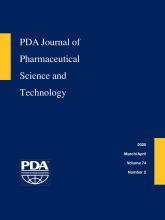Note to pda.org users
The PDA and PDA bookstore websites (www.pda.org and www.pda.org/bookstore) are separate websites from the PDA JPST website. When you first join PDA, your initial UserID and Password are sent to HighWirePress to create your PDA JPST account. Subsequent UserrID and Password changes required at the PDA websites will not pass on to PDA JPST and vice versa. If you forget your PDA JPST UserID and/or Password, you can request help to retrieve UserID and reset Password below.
Log in using your username and password
Log in through your institution
You may be able to gain access using your login credentials for your institution. Contact your library if you do not have a username and password.
If your organization uses OpenAthens, you can log in using your OpenAthens username and password. To check if your institution is supported, please see this list. Contact your library for more details.
Purchase access
You may purchase access to this article. This will require you to create an account if you don't already have one.
patientACCESS
patientACCESS - Patients desiring access to articles






